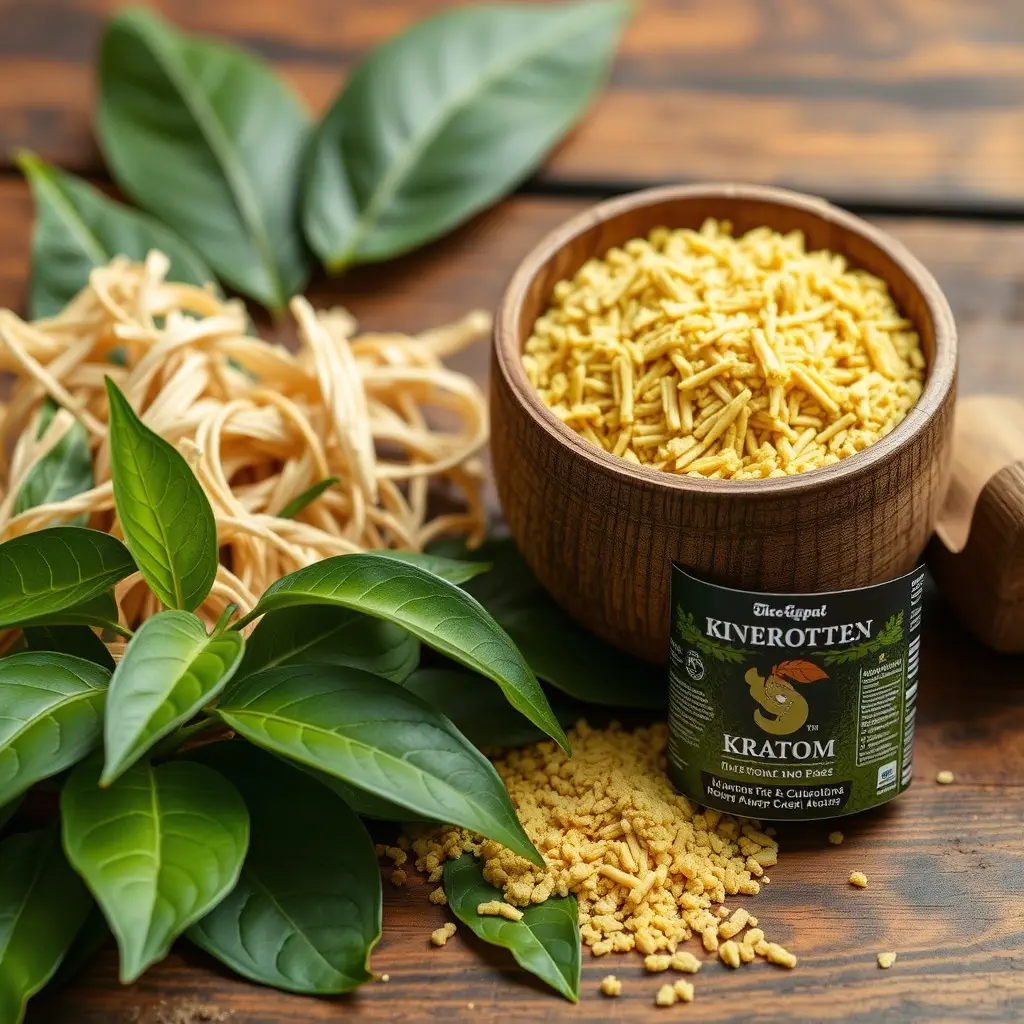Muscle soreness from intense physical activity or age can cause discomfort or pain and impact daily activities. Kratom, derived from Mitragyna speciosa, is being explored as a natural remedy for this issue due to its active compounds that may alleviate pain and inflammation through opioid receptor interaction and potential anti-inflammatory properties. However, it's crucial to exercise caution with kratom because of its legal status, variability in effects, lack of standardized dosing guidelines, and the risk of misuse. Kratom has a similar chemical profile to opioids, which can lead to positive results on opioid tests, including those within military contexts like the U.S. Army, prompting stringent regulations and testing protocols due to its controlled substance status. The Army's stance is part of a broader effort to maintain safety and readiness among service members, and individuals in such environments should consult healthcare professionals or refer to official directives before considering kratom as part of their wellness routine, given the implications of its use.
Muscle soreness can be a significant hurdle for both athletes and casual exercisers alike, often impeding recovery and performance. Exploring effective relief strategies is thus paramount. This article delves into the potential of kratom supplements as a means to alleviate muscle soreness, with a focus on its mechanisms, benefits, and safe usage within physical activity regimens. We’ll examine how various kratom strains can be utilized, along with appropriate dosage guidelines. Additionally, given the increasing scrutiny of performance-enhancing substances in military settings—as evidenced by queries like “Does the army test for kratom?”—we will provide a comprehensive guide on balancing physical exertion with kratom intake, including insights into the Army’s stance on its use and testing.
- Understanding Muscle Soreness and Kratom's Role: An Overview of Its Mechanisms and Potential Benefits
- Kratom as a Natural Remedy for Muscle Soreness: Exploring Strains and Dosage Considerations
- Balancing Physical Activity and Kratom Use: A Guide to Safe Practices and the Army's Stance on Kratom Testing
Understanding Muscle Soreness and Kratom's Role: An Overview of Its Mechanisms and Potential Benefits

Muscle soreness, often characterized by discomfort or pain in the musculoskeletal system, can arise from various activities including intense exercise, overuse, or even from age-related changes. The experience of muscle soreness ranges from mild tenderness to severe pain that can impede daily activities and hinder recovery. Understanding the underlying mechanisms of muscle soreness is crucial for effective management. It typically involves inflammation and oxidative stress within the muscle tissue, which can be exacerbated by the breakdown of tissues during physical activity.
Kratom, a plant-based supplement derived from Mitragyna speciosa, has gained attention for its potential in alleviating muscle soreness. The active compounds found in kratom, primarily mitragynine and 7-hydroxymitragynine, interact with the body’s opioid receptors, which can help manage pain perception. Preliminary research suggests that kratom may offer anti-inflammatory properties, potentially reducing the swelling and inflammation associated with muscle soreness. Additionally, its analgesic effects contribute to the reduction of chronic pain in some individuals. While the scientific community continues to explore kratom’s mechanisms and benefits, users report anecdotal relief from muscle aches, which may be attributed to these natural compounds. In certain contexts, such as within military personnel or those undergoing rigorous training, the question of whether the army tests for kratom use arises due to its potential impact on performance and health. It’s important to approach the use of kratom with caution, as it is a controlled substance in some regions and its long-term effects are still being evaluated. Those interested in using kratom as a supplement for muscle soreness relief should consult with healthcare professionals to ensure safe and responsible usage.
Kratom as a Natural Remedy for Muscle Soreness: Exploring Strains and Dosage Considerations

Kratom, a tropical evergreen tree native to Southeast Asia, has garnered attention in various circles, including natural remedy enthusiasts and those exploring alternative pain management solutions. Its leaves contain compounds known as alkaloids, which are believed to interact with the body’s opioid receptors, potentially providing pain relief. When it comes to muscle soreness, kratom is often considered for its analgesic properties. Among the many strains of kratom available, some are more favored for their pain-relieving effects. Red Bali and Red Maeng Da strains, for instance, are commonly reported to offer significant relief from muscle aches and pains. However, it’s crucial to approach kratom use with caution due to its potency and the wide range of alkaloid concentrations between strains and batches.
Dosage is another critical factor when considering kratom for muscle soreness relief. Unlike pharmaceutical options, there are no universally established dosing guidelines for kratom. Users should start with a low dose to gauge their individual response, as tolerability can vary greatly. It’s also important to be mindful of the timing of ingestion, as the effects of kratom can last several hours and may accumulate if taken too frequently. While some individuals may find relief at doses as low as 2 grams, others might require a higher dose for similar effects. Nevertheless, it’s advisable to adhere to the ‘start low and go slow’ principle when experimenting with kratom. Additionally, due diligence should be exercised if the individual is subject to drug testing, such as military personnel, as some strains of kratom can trigger positive results on tests designed to detect opioids. Always consult with a healthcare professional before incorporating kratom into your wellness regimen, especially if you are part of an organization that conducts regular drug screenings like the army. Does the army test for kratom? While specific policies may vary, it’s essential to be aware that kratom’s alkaloid profile can result in a positive opioid test, which could have significant implications for military personnel and others under similar testing mandates.
Balancing Physical Activity and Kratom Use: A Guide to Safe Practices and the Army's Stance on Kratom Testing

When integrating kratom supplements into a fitness regimen, it’s crucial to maintain a balance that promotes both muscle recovery and overall health. Kratom, derived from the leaves of Mitragyna speciosa, has been reported by some users to provide pain relief and enhance physical performance, which can be beneficial for those engaging in regular exercise or training. However, because kratom interacts with the body’s opioid receptors, its use should be approached with caution, particularly when balancing it with the demands of physical activity. Users are advised to start with low doses and carefully monitor their body’s response. Additionally, staying hydrated and observing proper nutrition remains key to supporting muscle recovery and preventing overexertion.
In the context of organized physical activities, such as those conducted within military environments, the stance on kratom testing varies. The United States Army has specific regulations regarding the use of supplements and controlled substances. While kratom is not a traditional opiate, it falls under the category of drugs that are monitored due to their potential for misuse and their impact on physical performance and mental acuity. As such, does the army test for kratom is a pertinent question for individuals serving in the military. The Army’s testing protocols are designed to ensure the safety and readiness of its personnel, and as kratom’s legal status and research evolve, these standards may also adapt. Prospective users should be aware of the potential consequences within regulated environments and consult with healthcare professionals or refer to official military guidelines before incorporating kratom into their wellness practices.
Muscle soreness can be a significant hindrance to maintaining an active lifestyle. The article has explored the multifaceted relationship between muscle soreness and the potential benefits of kratom supplements, shedding light on their mechanisms of action and safe usage considerations. Kratom’s role as a natural remedy for alleviating muscle discomfort has been examined, highlighting the importance of selecting appropriate strains and dosages to optimize its effects. Furthermore, the article addressed the pertinent topic of balancing physical activity with kratom use, including insights into the Army’s stance on kratom testing, as it pertains to fitness regimens and workplace safety. In conclusion, for those seeking alternative methods to manage post-exercise muscle soreness, understanding the role of kratom and its implications in various contexts, such as within military testing protocols, is crucial for informed decision-making.






